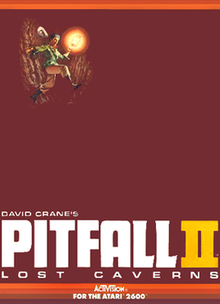| Pitfall II: Lost Caverns | |
|---|---|
 Atari 2600 cover art | |
| Developer(s) | Activision[5] |
| Publisher(s) | Activision[5] |
| Designer(s) | David Crane |
| Series | Pitfall |
| Platform(s) | Atari 2600, Atari 5200, Atari 8-bit, ColecoVision, Commodore 64, IBM PCjr, Apple II,[3] MSX, ZX Spectrum |
| Release | |
| Genre(s) | Platform[6] |
| Mode(s) | Single-player |
Pitfall II: Lost Caverns is a video game developed by David Crane for the Atari 2600. It was released in 1984 by Activision. The player controls Pitfall Harry, who must explore in wilds of Peru to find the Raj Diamond, and rescue his niece Rhonda and their animal friend Quickclaw. The game world is populated by enemies and hazards that variously cause the player to lose points and return to a checkpoint.
The game was a sequel to Pitfall! (1982), one of the best-selling Atari 2600 video games. Crane said the Atari 2600 hardware was out of date when developing the sequel, which led to him creating a custom computer chip called the Display Processor Chip for Pitfall II: Lost Caverns. This allowed for more complex graphics and background music in the game. It became the top selling console game of the year and was ported to other consoles and home computers.
Pitfall II received positive reviews with the expanded gameplay of the game, with the more positive reviews of the game finding it superior to Pitfall!. Retrospective reviews have continued to be positive, with Retro Gamer listing it as the best game on the Atari 2600 and other critics noting its gameplay innovations, such as being among the first games to include a checkpoint system.
- ^ "The Wherehouse - Where You'll Love These Prices". The Californian. February 17, 1984. p. 21. Retrieved December 12, 2023.
Activision//New!//Pitfall II: Lost Caverns
- ^ "Availability Update". Computer Entertainer includes The Video Game Update. Vol. 3, no. 7. October 1984. p. 112.
- ^ a b Zuckerman 1984, p. 82.
- ^ "Availability Update". Computer Entertainer includes The Video Game Update. Vol. 3, no. 9. December 1984. p. 144.
- ^ a b Weiss 2014, p. 172.
- ^ Schneider 2023.